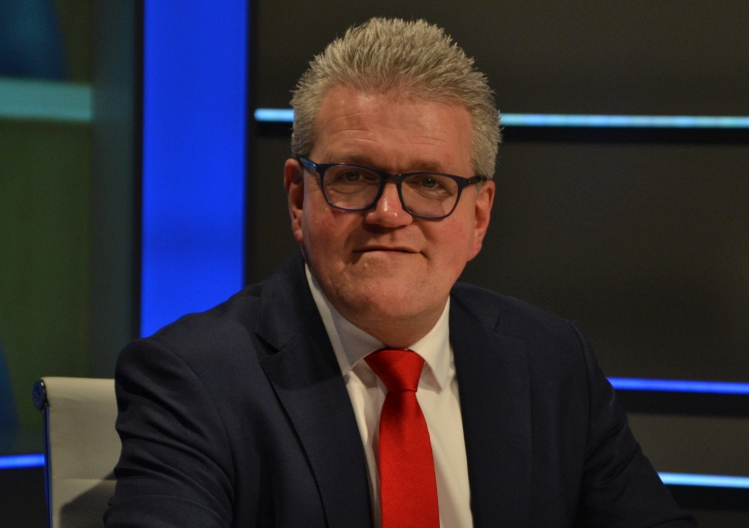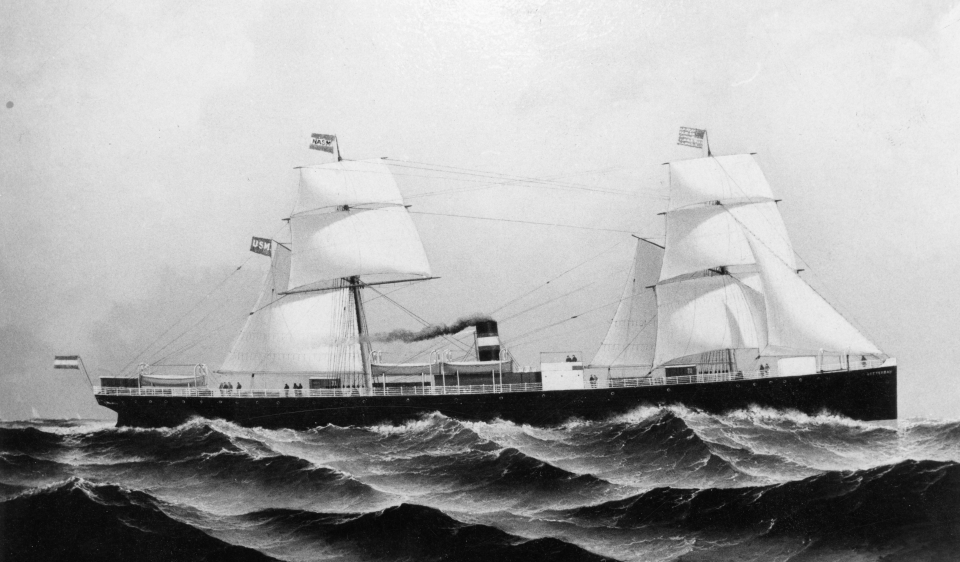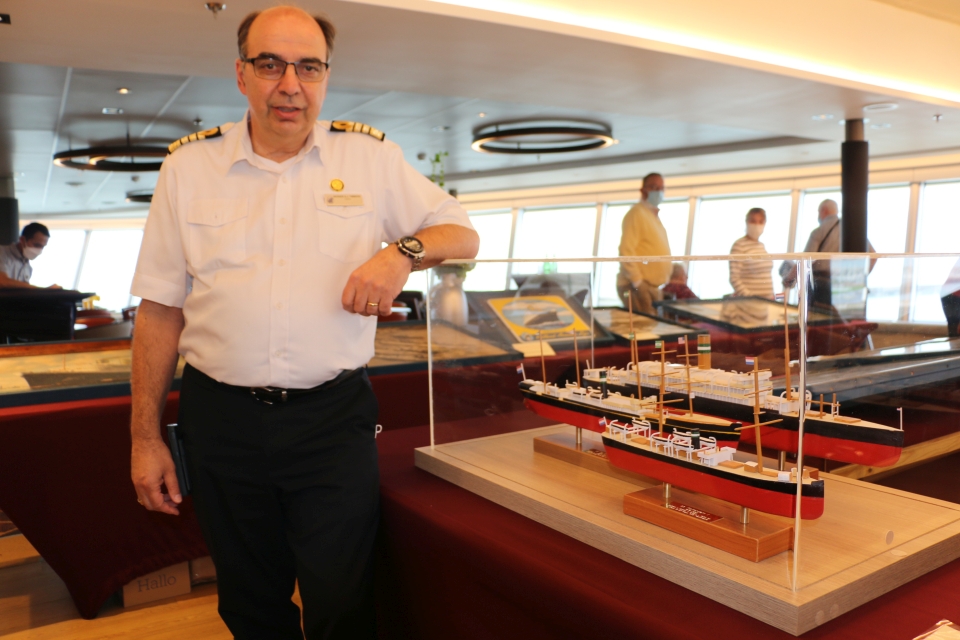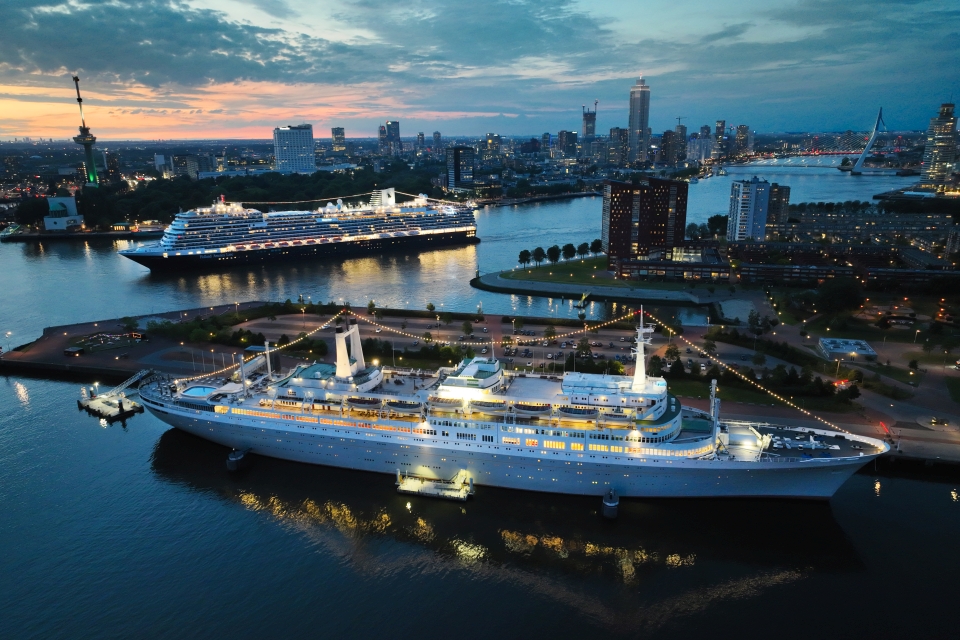Holland America Line’s brand new flagship Rotterdam (VII) crossed the Atlantic in October, from Rotterdam to New York, in honour of 150 years of Holland America Line. According to the captain, the ship is more economical than a car.

This article was written by maritime journalist Riekelt Pasterkamp, who stayed on board the Rotterdam during the crossing and spoke to the ship’s captain. It was published in SWZ|Maritime’s December 2022 issue.
‘There are waves along the way.’ The announcement sounds like an open door when Werner Timmers, captain of the Rotterdam VII, addresses his passengers via the ship’s broadcaster. He means: There will be swell, the ship will move. We are crossing the Atlantic Ocean. There are waves up to six metres during the trip.
On an early Friday morning, this is noticeable. Waves break on the bow, the ship shakes and vibrates. Fortunately for those on board, the brand new Rotterdam VII is equipped with stabilisers: fold-out fins that dampen the swing of the ship. The Rotterdam was delivered in the summer of 2021 by the Fincantieri shipyard in Italy. On 30 May of this year, Princess Margriet of the Netherlands gave the ship its name. The ship then spent the summer exploring Northern Europe and the Baltic Sea on round trips from Amsterdam.
Timmers – who has been with the Holland America Line (HAL) for 35 years – left Rotterdam on 15 October and arrived in New York on 26 October. A journey of 3200 nautical miles, almost 6000 kilometres. Sailing day and night. The voyage was a tribute to his distant predecessor, Captain J. Hus. 150 years ago, he was the first HAL captain to cross the ocean with the Rotterdam I. His barge was 82 metres long, Timmers’ 300. Then, the Rotterdam sailed on coal and steam, now on gas oil. Then the journey took fifteen days, now only half that.

Blankets
At the time, there was not an ounce of luxury: emigrants had to bring their own blankets and eating utensils and slept in bunk beds of four high. The crossing was not cheap: converted to the currency of today, passengers with a cabin paid about 3400 euros. Emigrants had to pay around 2000 euros for their trip.
No Spartan conditions are found on board Rotterdam VII. The over 2000 passengers are pampered by nearly 1000 employees. They can splash in two pools, work out in a fitness centre and waste their money in a gambling hall. The menus are composed by star chefs. There is plenty of food: from takeaway fries to a three-course dinner. For specialty restaurants, an extra grip in the pouch is necessary. For those who want to withdraw, there is plenty of room.
Yet, there are separate worlds on board a cruise ship. Those of Ali, Romeo, Mook and their 900 colleagues, mostly Asians. And those of George, Helen, Nancy and the other guests, mostly Americans. The worlds meet a few times a day. When eating, when cleaning the cabin, when being subservient all the time. But otherwise, there are separate worlds with seperate dining rooms, stairwells and decks for sleeping.
Also read: Princess Margriet of the Netherlands christens HAL’s newest cruise ship Rotterdam
Seven times Rotterdam
As long as the Holland America Line has existed, there has been a ship named Rotterdam in the fleet. According to shipping expert Bram Oosterwijk, author of the book “Six times Rotterdam”, about the history of HAL ships, it has never happened that a shipping company gives a ship the same name for the seventh time. The history at a glance.
I. The first Rotterdam was launched in 1872. This steamship (which also had sails) was used for passenger shipping between Rotterdam and New York. The ship had room for cabin passengers, emigrants and cargo. The first trip went from Rotterdam via Hellevoetsluis, Brouwershaven and Plymouth to New York, where it arrived on November 5th. Captain was J. Hus. In September 1883, the ship came to an end when, on its 65th return from New York, it ran aground off the coast of Schouwen-Duiveland.
II. The second Rotterdam sailed from 1886 to 1895. It was the first HAL ship to take a cruise, in 1895. On the occasion of the official opening of the Kiel Canal between the Baltic Sea and the North Sea, several shipping companies were invited to provide a cruise.
III. ‘A floating palace’, that’s how the Rotterdamsch Nieuwsblad described the third Rotterdam in August 1897. This ship was built at Harland & Wolf in Belfast – later known for the Titanic – and only sailed for a short time. In 1906, HAL sold it again. On June 18, 1918, it sank under the name Dwinsk near Bermuda due to a torpedo impact.
IV. The fourth Rotterdam sailed between 1908 and 1940. After that, the ship was demolished.
V. In 1959 came the Rotterdam V, also known as “The Grande Dame”. The ship has become famous for its many world cruises. The last one was in 1997. Shortly thereafter, it was sold and started sailing under the name Rembrandt in the United States. When the message trickled through that the Rotterdam would go out, Oosterwijk mobilised the city. After several wanderings, it arrived in Rotterdam in 2008 and now serves as a hotel and museum ship. ‘The Rotterdam is now forever at home.’
VI. In the meantime, the sixth Rotterdam sailed around the world from its home port of Rotterdam. This ship sailed from 1997 to 2020. It was sold to Fred Olsen Cruise Lines. According to Oosterwijk, the V and VI cannot be compared. ‘The V was a passenger ship. They sailed with passengers from a to b. The VI was much more luxurious and served holidaymakers. The V had a “sieve”, a curve in the line. The current ships are straight with all balconies.’
VII. The Rotterdam VII was delivered in the summer of 2021 by the Italian shipyard Fincantieri. On 30 May of this year, Princess Margriet gave the ship its name in Rotterdam. The Rotterdam VII is almost 300 metres long, has 2660 beds and has almost 1000 crew members.
Virus
From Rotterdam, the ship first went to Le Havre and a day later to the British port city of Plymouth. The mandatory face mask took some getting used to. Just before embarkation in Rotterdam, HAL reported to all passengers that during the previous cruise, ‘an increasing number of cases of gastrointestinal infections’ had surfaced on board, an inflammation of the gastrointestinal tract. Symptoms include diarrhea, vomiting and abdominal pain. How many passengers became ill, HAL did not report. However, in consultation with ‘various international health authorities’, the virus has been brought under control.
A rapidly spreading virus is a nightmare for cruise lines. Especially if the average age of the passengers on board is seventy-plus. During the Covid pandemic, the entire cruise industry came to a standstill. Personnel were sent home, ships were docked in ports or sat idle at sea. The market is slowly returning. According to HAL historian Bill Miller (nickname: Mister Oceanliner), more and larger cruise ships than ever seen before are being built. The shipyards in Finland, Germany, France and Italy benefit from it.
The problem is finding suitable staff. According to Timmers, shipping worldwide will need 100,000 people in the coming years. ‘Everyone is looking for suitable people.’ Officers at HAL are three months up, three months off. Kitchen and hotel staff will remain on board for nine months. Timmers does not dare to say whether it will ever come to autonomously crossing the Atlantic Ocean. ‘The technology can handle it. But whether the passengers accept that there is no one on the bridge, I don’t know. They now trust me to take them safely to the other side.’
Also read: HAL cruise ship Volendam to house Ukrainian refugees in Port of Rotterdam
Smokestacks
Emissions and climate are a thing these days. Not in the old days, Miller knows. ‘There were two stories among emigrants and passengers. One: The more smokestacks a ship had, the safer it was. Companies therefore had fake smokestacks placed on their ships. And two: if you ate raw onions a month before your trip across the ocean, you didn’t get seasick.’
Everywhere on the Rotterdam VII, there are signs with the request to ‘respect the ocean and the law’. So do not throw butts or food items overboard, let alone empty glasses or cutlery. Paper, cans and bottles are collected separately. Water is extracted from the sea on board, freshened, used and cleaned and goes back into the sea clean. Recycling at its best.
However, the choice of the shipping company to sail its flagship on (admittedly low-sulphur) gas oil remains remarkable, while other cruise lines do switch to cleaner fuels, such as liquefied natural gas (LNG). The HAL is doing a (modest) test with biofuel. But the Rotterdam VII still vomits yellow smoke along the way.
Also read: Holland America Line’s new Rotterdam repeats first Rotterdam’s maiden voyage
Car
‘This ship is more economical than your car,’ captain Timmers dares to state. ‘We sail 28 nautical miles on a gallon of gas oil. That’s not bad’ (51.8 kilometres at 3.78 liters, so one in thirteen per person). When it comes to the footprint in terms of pollution, the captain uses a handy calculation: one person one week on a cruise ship costs one and a half trees. ‘Two weeks costs two so six trees. Buy them when you’re at home.’
Timmers regularly shows himself among the passengers. The question time “Ask the captain” is extremely popular. Of course, he is asked how to avoid icebergs. Answer: ‘We keep it in the glass.’ Or: How far can the ship bend before it breaks? Answer: ‘We won’t know until then.’
Timmers prefers to talk about his hobby: building ship models. For this special crossing, he made models of the Rotterdam I, II and III from waste material. ‘A person has to do something to stay off the streets.’ Nicely said for a sailor.

Picture (top): The Rotterdam V (foreground) and Rotterdam VII in May 2022 in the port of Rotterdam (by HAL).
Also read: Holland America Line sells four cruise ships in 2020








